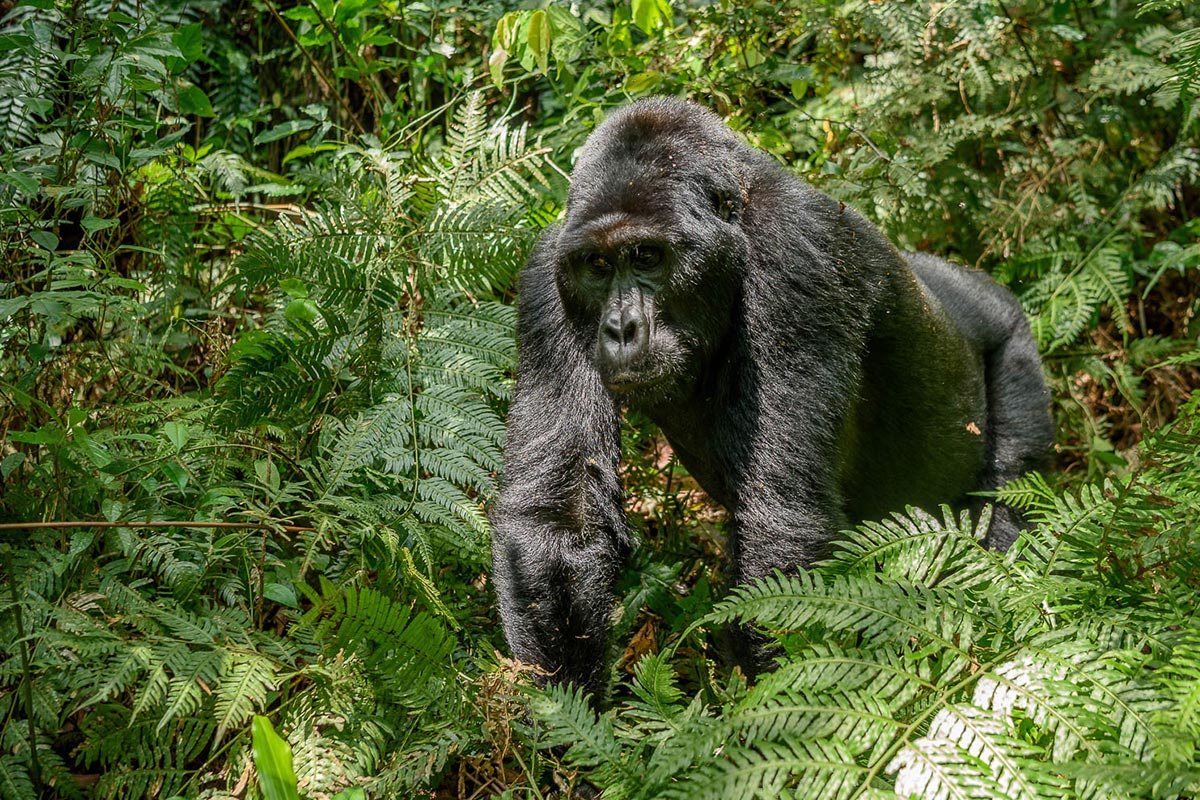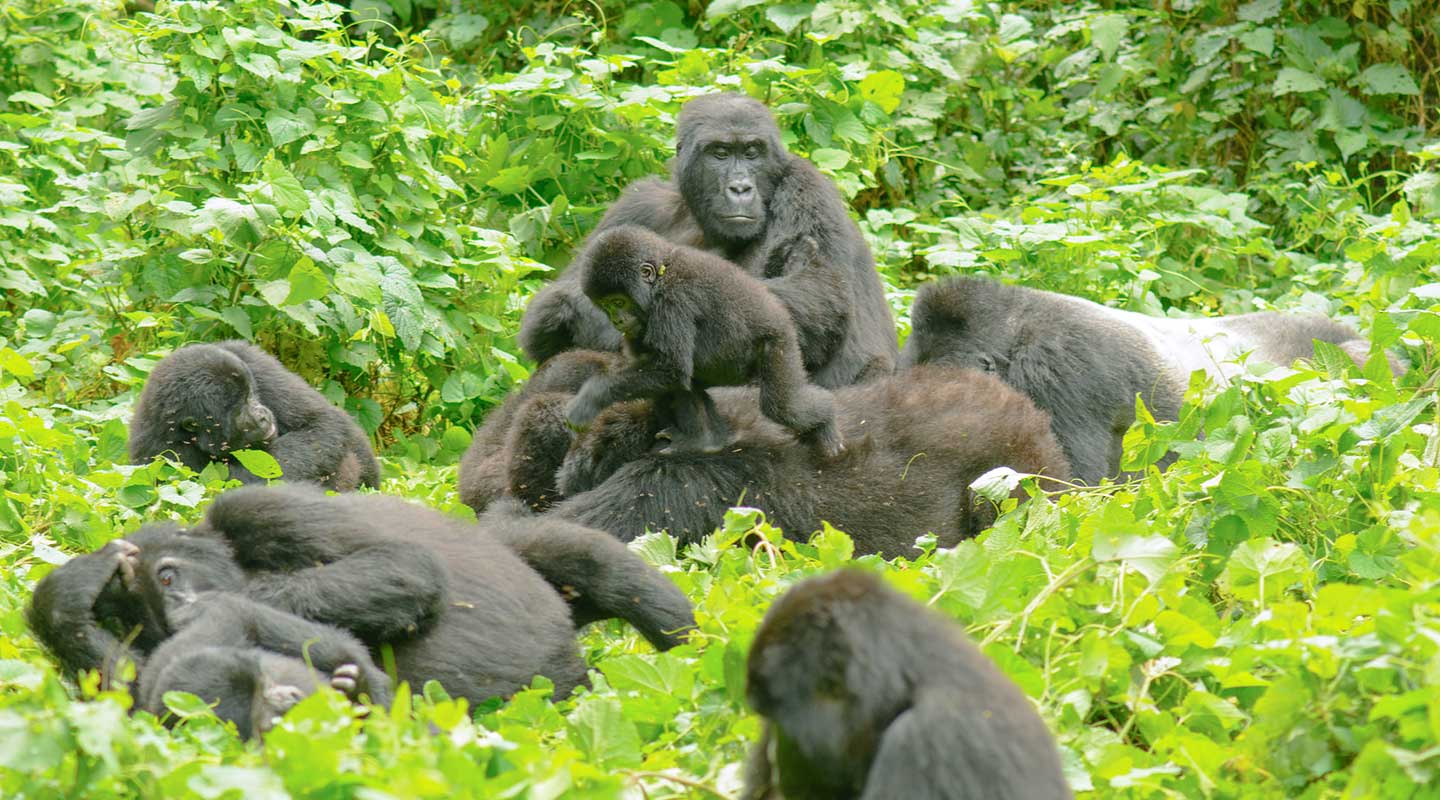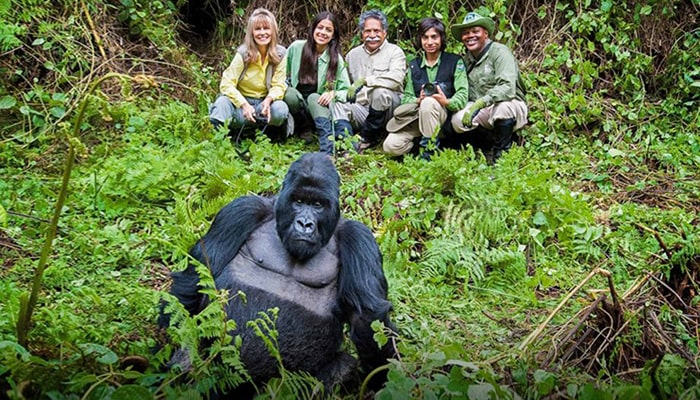Bwindi Impenetrable National Park
Bwindi Impenetrable National park is one of the most recognized and popular safari destinations in Uganda located in the southwestern region of Uganda, this national is situated on the edge of the western Albertine rift valley covering an area of 321 square kilometers and stretching through three districts that are Rukungiri, Kisoro, and Kabale districts.

Bwindi Impenetrable National Park is heavily forested with rain-forests and it is one of the few areas on the African continent with rain forests to have flourished throughout the last ice age, the park lies in the range of 116o meters above the sea level in Ishasha gorge to 2607 meters at Rwamanyonyi peak.
The heavy rain forests of safari tours in Bwindi impenetrable national park are home to the huge endangered mountain gorillas, mountain gorillas are the prime reason why Bwindi impenetrable national park is visited by a huge population of tourists per year.
The park is home to over half of the world’s population of mountain gorillas with over 600 individuals living in the four sectors of the park that are Buhoma sector, Nkuringo sector, Ruhija, and Rushaga sector.
There is a huge population of mountain gorillas in Bwindi impenetrable national park but to support the mountain gorilla trekking experience the trademark safari activity of the park, some of the mountain gorillas were put through the gorilla habituation process.

Gorilla habituation helps to make the mountain gorillas comfortable with human presence, habituated mountain gorilla groups in Bwindi impenetrable national park are 19 in number and they include Mubare, Habyinyanja, Rushegura, Katwe, Nkuringo, Bushaho, Christmas, Bitukura, Oruzogo, Mukiza, Nshongo, Mishaya, Bweza, Kahungye, Busigye, Bikyingi, Rwingi, and Mucunguzi.
On addition to Mountain gorillas, Bwindi impenetrable national park habits 90 mammal species with 11 primate species, 360 species of birds, 200 species of butterfly, and 324 plant species including ferns, vine, and shrubs. Mammal species in Bwindi national park include forest, elephants, duikers, bush pigs, giant forest hogs, black-fronted duiker, yellow-backed duiker, clawless otter, civet, side-striped jackal, black and white colobus monkeys, L’Hoest monkeys, De Brazza monkeys, Red-tailed monkeys, olive baboons, Chimpanzee, Demidoff’s Galago and Spectacled Galago.

Birds in Bwindi impenetrable national park include 23 Albertine endemics, 14 species only found in Bwindi and nowhere in Uganda, and globally threatened species.
These birds include Grauer’s broadbill, Chapin’s Flycatcher, Shelley’s Crimson-wing, Handsome Francolin, Mountain-masked, and Collared Apalis, White-bellied Robin-Chat, Black-billed Turaco, Fraser’s Eagle, Western Bronze-naped Pigeon, Purple-breasted, Blue-headed and Regal Sunbirds, and many more. Butterflies species in Bwindi impenetrable national park 8 Albertine rift endemics and they include African giant swallowtail, cream-banded swallowtail, and many more. In Bwindi impenetrable national park, there are 27 amphibian species with 11 Albertine rift endemics, 14 snake species, and 14 lizard species.
Bwindi Impenetrable National Park is a known home for a diverse ecology and one of the few places with both montane and lowland forests with many species of flora and fauna, Bwindi Impenetrable National Park was first gazetted in 1932 with two blocks designated as crown forest reserves covering an area of 207 square meters.
The northern block was designated as Kayonza crown forests reserve and the southern block was designated as Kasatora crown forest reserve, in 1942 the two reserves were combined as one and renamed the impenetrable central crown and their size was adjusted to cover 298 square kilometers.
In 1964, the reserve was declared an animal sanctuary in order to offer protection to the endangered mountain gorillas and its name was changed to Impenetrable Central Forest Reserve.
In 1966 the two forests were added to the main reserve to cover an area of 321 square kilometers, the park was managed as both a game sanctuary and a forest reserve until 1991 when it was added to Mgahinga Gorilla Reserve and Rwenzori Mountains Reserve to create the present Bwindi impenetrable national park. In 1994, the park was designated as a World Heritage Site by the United Nations Educational Scientific and Cultural Organization (UNESCO)
Activities to do in Bwindi Impenetrable National Park
Mountain Gorilla trekking
Mountain gorilla trekking is the prime safari activity to do in Bwindi national park, the forests of Bwindi habit over half of the world’s mountain gorilla population which are meet on mountain gorilla trekking in their natural habitat.
Mountain gorilla trekking offers a visit to any of the 19 habituated gorilla families per day, only a group of 8 individuals above the age of 15 years with mountain gorilla trekking permits are allowed to participate in this adventurous activity.
At the start of mountain gorilla trekking, you are taken through rules and regulations to follow when in presence of mountain gorillas because the gorilla is very sensitive to animals. Locating for mountain gorillas takes about 3-6 hours and when you find the mountain gorillas you are allowed to stay only 1 hour in the presence of mountain gorillas.
It is unavoidable not to take pictures and it is allowed as long as your camera’s flashlight is off, when you are going to this safari you go with your packed lunch.

Bird watching
Bwindi national park is one of the best destinations for bird watching activity and has been recognized as Africa’s number one birding spot by Africa Bird Club, the thick forests of the park are home to over 350 bird species with 23 Albertine Rift endemics and 14 species only found in Bwindi impenetrable national park.
Bird watching activity in Bwindi national park offers excellent sights of various bird species such as Shelley’s Crimson-wing, Handsome Francolin, Mountain-masked, and Collared Apalis, White-bellied Robin-Chat, Black-billed Turaco, Fraser’s Eagle, Western Bronze-naped Pigeon, Purple-breasted, Blue-headed and Regal Sunbirds and many more.
Butterflies species in Bwindi impenetrable national park 8 Albertine rift endemics and they include African giant swallowtail, cream-banded swallowtail, and many more.
Bird watching in Bwindi national park is best done in the morning and evening, for the best experience, it is advised to carry a pair of binoculars for excellent sights of the birds and for security purposes and more enriched experience birders are escorted by an experienced birding guide and rangers.

Nature walks
Bwindi impenetrable national park is an ideal destination for nature lovers, nature walks are done on various trails running through the thick forests leading to various attractions in the park such as waterfalls. Nature walk trails in Bwindi national park include
- Buhoma – Nkuringo trail taking 4-5 hours of completion
- Rushura hill walk trail running through the forests between Congo and Uganda
- Muyanga water walk trail leading to the magnificent Muyanga waterfall
- Ivi Riverwalk trail of 14 kilometers taking 7 hours to completion
Muzubijiro loop of 6 kilometers

Batwa cultural tours
The Batwa people are the early inhabitants of the forests of Bwindi, unfortunately, they were forced out of the forests during the gazetting of the area as a national park. Currently, these pygmy people live on the outskirts of the park and they are visited on the Batwa trail on which tourists get an insight into their local lifestyle and way of doing things. On Batwa culture you will be entertained by local dances and songs, observe hunting skills, building houses using local materials, collecting of local herbs as demonstrated by the Batwa people.
Where to stay in Bwindi Impenetrable National Park
To get a lodge or camp to stay at while on a safari in Bwindi impenetrable national park depends on the sector of the park you assigned to trek, there is a number of lodges and camps offering tourists a place to stay at and they are as follows
In Buhoma sector there are Buhoma lodge, Bwindi lodge, Sanctuary gorilla forest lodge, Mahogany springs, Buhoma Haven Lodge, Silverback Lodge, and Buhoma Community Rest Camp
In Rushaga sector there are Chameleon Hill, Bwindi Jungle Lodge, Ichumbi Gorilla Lodge, Rushaga Gorilla Camp, and Gorilla Valley Lodge
Ruhija sector there are Bakiga Lodge, Broadbill Forest Camp, and Agandi Lodge
Nkuringo sector there are Clouds Mountain Gorilla Lodge and Nkuringo Safari Lodge
How to get to Bwindi impenetrable national park
Depending on the preference there are many possible ways used to get to Bwindi impenetrable national park for a safari, Bwindi impenetrable national park is found in the southwestern region of Uganda and the park is accessed from either Kigali the capital city of Rwanda, or Kampala the capital city of Kampala using both air and road means.
By road, from the park is accessed using various routes including
- Kampala – Kabale – Ruhija route
- Kampala – Ntungamo – Rukungiri – Kihihi – Buhoma/Nyondo route
- Kampala – Kabale – Kisoro – Rushaga/Nkuringo.
By air, Bwindi impenetrable national park is served by 3 airstrips that are Nyakabande airstrip, Kisoro airstrip, and Kihihi airstrip. Chartered domestic flights to Bwindi impenetrable national park are offered from either Entebbe international airport or Kajjansi airstrip to any of the 3 airstrips serving the park. Domestic flights to Bwindi Impenetrable national park is offered by Aero ling, fly uganda and many more flight companies.




